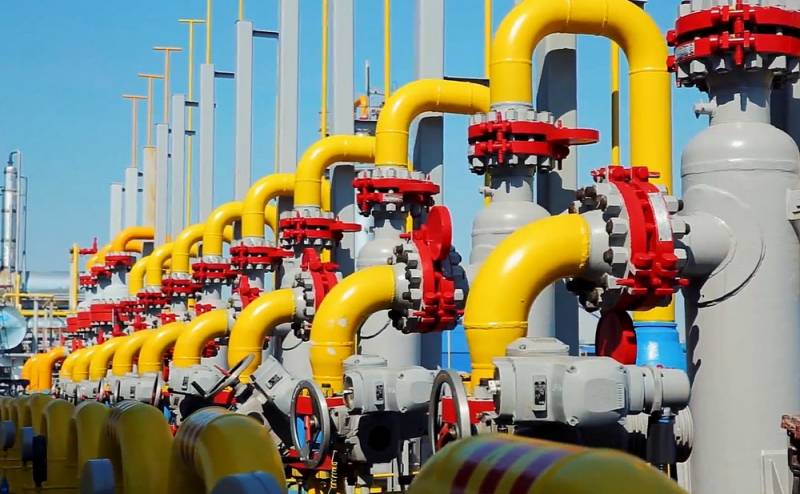What will Ukraine's attempt to turn into a gas hub turn into?
The recent decision of the United States and Germany to come to a compromise on the future fate of Nord Stream 2 has caused in Ukraine the effect of a pack of yeast thrown into a village sanctuary. Despite a convincing request from senior comrades to refrain from public criticism, Kiev has threatened to continue its relentless struggle against the pipeline. There was also a proposal to turn Nezalezhnaya into a European gas hub, which would supposedly solve all its problems. It is clear that all these statements are made to an internal audience, but are there any rational grain in them?
Yury Kamelchuk, a representative of the Servant of the People party, spoke about the gas hub without blushing:
One of the simplest scenarios for what we can do is to become a gas hub for Europe using other gas pipelines. For example, Turkish gas, for example, from Iran or Azerbaijan, or even delivering LNG by ships, for example, from Qatar.
In order to appreciate his proposal, let's first understand what gas hubs are and how they work. The largest hubs in the world are Henry Hub, located in the US state of Louisiana, NBP (National Balancing Point), located in the UK, and Title Transfer Facility (TTF), located in the Netherlands. Also, Germany claims the role of a major European hub, which for the sake of Nord Stream 2 even went into conflict with the United States, and neighboring Poland could become a regional hub as the main distribution center of American LNG in the Old World. So what does it take to create a gas hub?
Of course, we need a lot of excess gas, both from our own production and from various sources - pipeline and liquefied. There is also a need for underground gas storage facilities and gas distribution networks, which will allow pumping "blue fuel" to customers in the shortest possible time. For example, Henry Hub is built on the world's largest gas transportation system, stretching from Canada to Mexico, as well as access to the richest domestic US market. British NBP is built around its own gas production in the North Sea, imports of LNG and pipeline gas from Norway. TTF arose around the largest gas field in the Netherlands, which has already been depleted, but all the necessary gas distribution infrastructure has been preserved, and it is possible to compensate for the shortfall through imports and resale of LNG.
What conclusions can we draw? For the hub to operate efficiently, a surplus of gas is needed, achieved through the maximum diversification of sources of its supply, and it also needs its own production to avoid price dictates on the part of exporters. We need a developed consumer base, as well as liberal legislation, which guarantees that local authorities will not meddle in the affairs of the hub if the policy goes against the interests of the host country. It is easy to see that only very economically developed countries such as the USA, Great Britain, Germany and the Netherlands, which are popular with businesses because of their flexible tax policy, can afford the role of a hub of global or regional significance. The question is, what of this does Independent have?
Let's get a look. There is a GTS, Ukraine inherited it from the USSR, as well as huge UGS facilities, so interesting to Germany. What else? There is domestic production in the country, but it does not even cover its own needs. As of 2019, the total production volume amounted to 20,7 billion cubic meters with a consumption of 29,8 billion, the deficit of which Kiev has to compensate from Russia through the so-called "virtual reverse". The plans to completely abandon the services of "Gazprom" at the expense of internal resources have completely failed. As for the Azerbaijani gas, which MP Kamelchuk proposes to take through Turkey, everything is very bad. The capacity of the southern bypass pipeline is only 10 billion cubic meters per year, and Baku is barely able to fulfill its obligations to European consumers. Liquefied natural gas from Qatar? The main export market for this emirate is still Asia (68%), where prices for "blue fuel" are noticeably higher, and Europe accounts for a little more than a quarter of the total supply (27%). Why the Qataris to drive their tankers to Ukraine in order to resell them later to the Europeans is not clear. By the way, if anyone in Kiev has forgotten, in 2014 and in 2015 Turkey already refused Nezalezhnaya in the passage of LNG tankers through its straits with the following wording:
The passage of liquefied natural gas (LNG) tankers is a problematic topic. Passing through an already busy strait can be dangerous. In addition, Istanbul is a very densely populated city. Any accident with an LNG tanker can cause a major tragedy.
In other words, Ukraine can forget about LNG as a source of diversification of supplies, Ankara itself claims to become a major Middle East gas hub, and it does not need any competitors here. Neither Germany nor Poland needs them either. Gas trading is a serious business for serious people, and not for modern Ukrainian "elites" who will not even get close to such a business. The maximum that Kiev is allowed is to continue pumping Russian gas to Europe as a transit country, while Nezalezhnaya should not even stutter about the gas hub as a pricing tool in the energy market and geopolitical pressure on the West.

Information